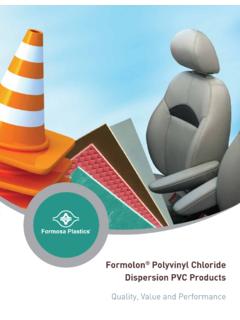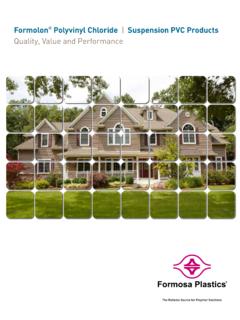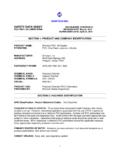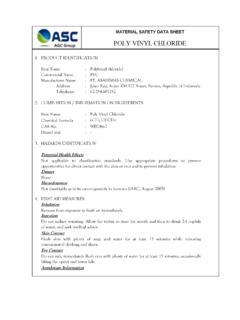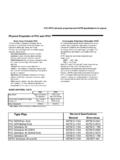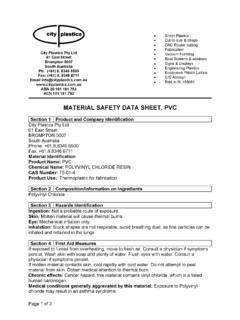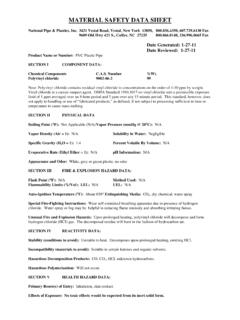Transcription of Vinyl Chloride in Drinking-water - WHO
1 WHO/SDE/ English only Vinyl Chloride in Drinking-water Background document for development of WHO Guidelines for Drinking-water Quality World Health Organization 2004 Requests for permission to reproduce or translate WHO publications - whether for sale of for non-commercial distribution - should be addressed to Publications (Fax: +41 22 791 4806; e-mail: The designations employed and the presentation of the material in this publication do not imply the expression of any opinion whatsoever on the part of the World Health Organization concerning the legal status of any country, territory, city or area or of its authorities, or concerning the delimitation of its frontiers or boundaries. The mention of specific companies or of certain manufacturers' products does not imply that they are endorsed or recommended by the World Health Organization in preference to others of a similar nature that are not mentioned.)
2 Errors and omissions excepted, the names of proprietary products are distinguished by initial capital letters. The World Health Organization does not warrant that the information contained in this publication is complete and correct and shall not be liable for any damage incurred as a results of its use. Preface One of the primary goals of WHO and its member states is that all people, whatever their stage of development and their social and economic conditions, have the right to have access to an adequate supply of safe drinking water. A major WHO function to achieve such goals is the responsibility to propose .. regulations, and to make recommendations with respect to international health matters .. The first WHO document dealing specifically with public Drinking-water quality was published in 1958 as International Standards for Drinking-water .
3 It was subsequently revised in 1963 and in 1971 under the same title. In 1984 1985, the first edition of the WHO Guidelines for Drinking-water Quality (GDWQ) was published in three volumes: Volume 1, Recommendations; Volume 2, Health criteria and other supporting information; and Volume 3, Surveillance and control of community supplies. Second editions of these volumes were published in 1993, 1996 and 1997, respectively. Addenda to Volumes 1 and 2 of the second edition were published in 1998, addressing selected chemicals. An addendum on microbiological aspects reviewing selected microorganisms was published in 2002. The GDWQ are subject to a rolling revision process. Through this process, microbial, chemical and radiological aspects of Drinking-water are subject to periodic review, and documentation related to aspects of protection and control of public Drinking-water quality is accordingly prepared/updated.
4 Since the first edition of the GDWQ, WHO has published information on health criteria and other supporting information to the GDWQ, describing the approaches used in deriving guideline values and presenting critical reviews and evaluations of the effects on human health of the substances or contaminants examined in Drinking-water . For each chemical contaminant or substance considered, a lead institution prepared a health criteria document evaluating the risks for human health from exposure to the particular chemical in Drinking-water . Institutions from Canada, Denmark, Finland, France, Germany, Italy, Japan, Netherlands, Norway, Poland, Sweden, United Kingdom and United States of America prepared the requested health criteria documents.
5 Under the responsibility of the coordinators for a group of chemicals considered in the guidelines, the draft health criteria documents were submitted to a number of scientific institutions and selected experts for peer review. Comments were taken into consideration by the coordinators and authors before the documents were submitted for final evaluation by the experts meetings. A final task force meeting reviewed the health risk assessments and public and peer review comments and, where appropriate, decided upon guideline values. During preparation of the third edition of the GDWQ, it was decided to include a public review via the world wide web in the process of development of the health criteria documents. During the preparation of health criteria documents and at experts meetings, careful consideration was given to information available in previous risk assessments carried out by the International Programme on Chemical Safety, in its Environmental Health Criteria monographs and Concise International Chemical Assessment Documents, the International Agency for Research on Cancer, the joint FAO/WHO Meetings on Pesticide Residues and the joint FAO/WHO Expert Committee on Food Additives (which evaluates contaminants such as lead, cadmium, nitrate and nitrite, in addition to food additives).
6 Further up-to-date information on the GDWQ and the process of their development is available on the WHO internet site and in the current edition of the GDWQ. Acknowledgements Vinyl Chloride in Drinking-water , Background document for development of WHO Guidelines for Drinking-water Quality, is an update of the background document published in the second edition of the Guidelines. The update was prepared by Dr J. Kielhorn, Fraunhofer Institute of Toxicology and Experimental Medicine, Germany, to whom special thanks are due. The work of the following working group coordinators was crucial in the development of this document and others in the third edition: Mr Fawell, United Kingdom (Organic and inorganic constituents) Dr E. Ohanian, Environmental Protection Agency, USA (Disinfectants and disinfection by-products) Ms M.
7 Giddings, Health Canada (Disinfectants and disinfection by-products) Dr P. Toft, Canada (Pesticides) Prof. Y. Magara, Hokkaido University, Japan (Analytical achievability) Mr P. Jackson, WRc-NSF, United Kingdom (Treatment achievability) The contribution of peer reviewers is greatly appreciated. The draft text was posted on the world wide web for comments from the public. The revised text and the comments were discussed at the Final Task Force Meeting for the third edition of the GDWQ, held on 31 March to 4 April 2003, at which time the present version was finalized. The input of those who provided comments and of participants in the meeting is gratefully reflected in the final text. The WHO coordinators were as follows: Dr J. Bartram, Coordinator, Water Sanitation and Health Programme, WHO Headquarters, and formerly WHO European Centre for Environmental Health Mr P.
8 Callan, Water Sanitation and Health Programme, WHO Headquarters Mr H. Hashizume, Water Sanitation and Health Programme, WHO Headquarters Ms C. Vickers provided a liaison with the International Chemical Safety Programme, WHO Headquarters. Ms Marla Sheffer of Ottawa, Canada, was responsible for the scientific editing of the document. Many individuals from various countries contributed to the development of the GDWQ. The efforts of all who contributed to the preparation of this document and in particular those who provided peer or public domain review comment are greatly appreciated. Acronyms and abbreviations used in the text CAA chloroacetaldehyde CAS Chemical Abstracts Service CEO chloroethylene oxide DNA deoxyribonucleic acid GC gas chromatography IUPAC International Union of Pure and Applied Chemistry LC50 median lethal concentration LED10 effective dose corresponding to the lower 95% limit on a dose associated with 10% response LOAEL lowest-observed-adverse-effect level NOAEL no-observed-adverse-effect level NOEL
9 No-observed-effect level PBPK physiologically based pharmacokinetic PVC polyvinyl Chloride uPVC unplasticized polyvinyl Chloride USA United States of America Table of contents 1. GENERAL DESCRIPTION .. 1 Identity .. 1 Physicochemical properties .. 1 Organoleptic 1 Major uses .. 1 Environmental 2 2. ANALYTICAL METHODS .. 2 3. ENVIRONMENTAL LEVELS AND HUMAN 2 Air ..2 3 Food .. 4 Estimated total exposure and relative contribution of 4 4. KINETICS AND METABOLISM IN LABORATORY ANIMALS AND HUMANS .. 4 5. EFFECTS ON LABORATORY ANIMALS AND IN VITRO TEST SYSTEMS .. 5 Acute 5 Short-term 5 Long-term exposure.
10 5 Reproductive and developmental toxicity .. 6 Mutagenicity and related 7 Carcinogenicity .. 7 6. EFFECTS ON 9 7. GUIDELINE VALUE .. 10 8. REFERENCES .. 11 1 1. GENERAL DESCRIPTION Identity CAS No.: 75-01-4 Molecular formula: C2H3Cl The IUPAC name for Vinyl Chloride is chloroethene; it is also known as monochloroethylene. Physicochemical properties1 (IPCS, 1999) Property Value Physical state Colourless gas Boiling point C Vapour density relative to air at 20 C Water solubility Slightly soluble ( g/litre) at 25 C Log octanol water partition coefficient Henry s law constant kPa m3/mol at 25 C; kPa m3/mol at 20 C Under ambient conditions, Vinyl Chloride is a colourless, flammable gas with a slightly sweet odour.










